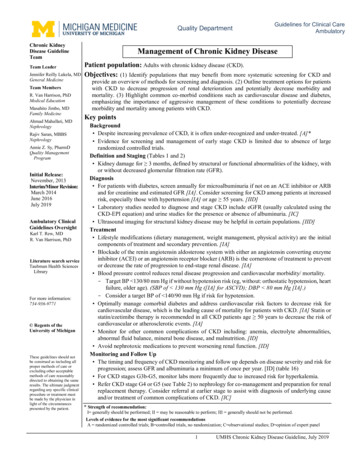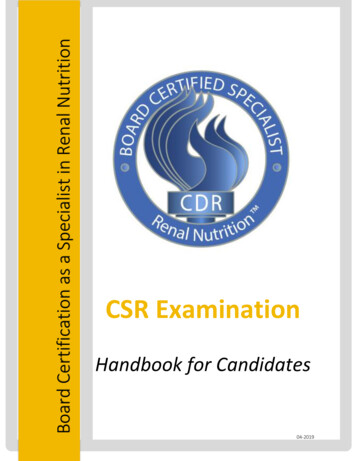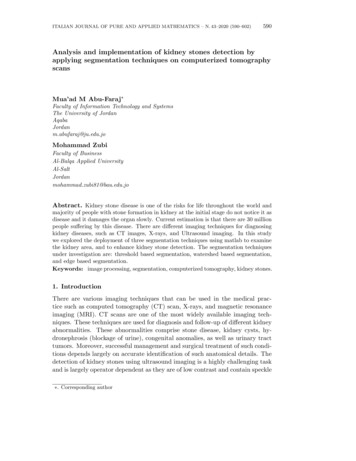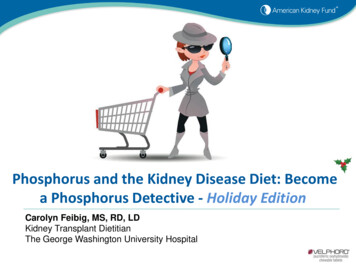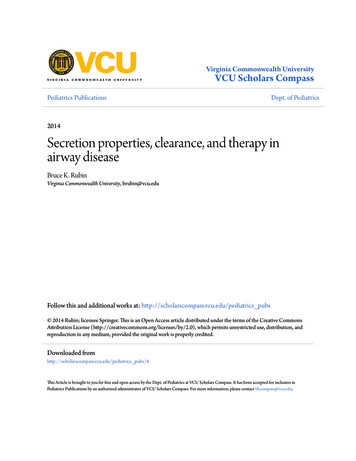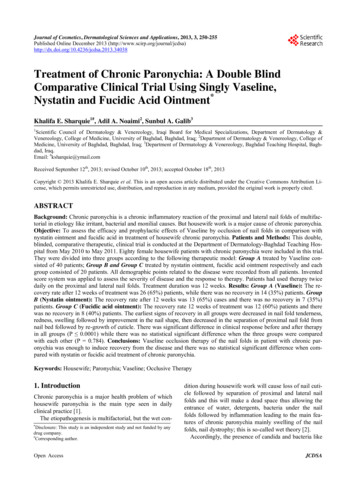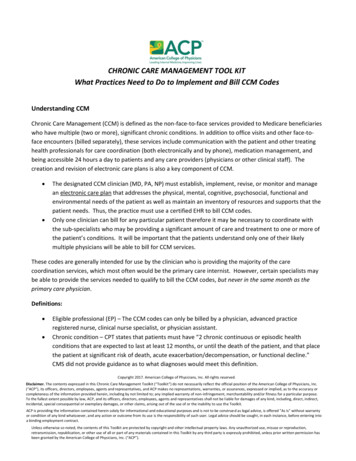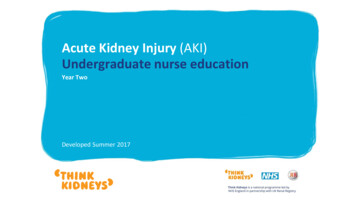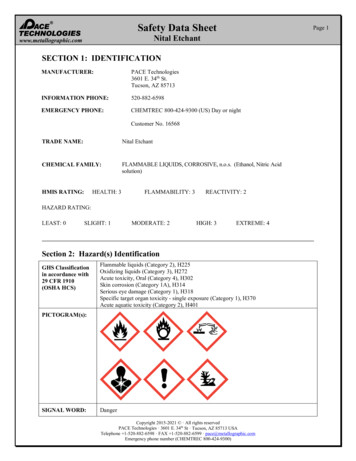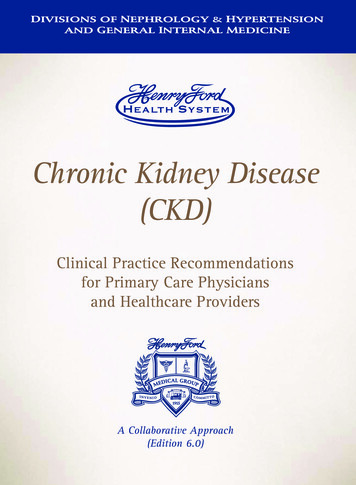
Transcription
DIVISIONS OF NEPHROLOGY & HYPERTENSIONAND GENERAL INTERNAL MEDICINEChronic Kidney Disease(CKD)Clinical Practice Recommendationsfor Primary Care Physiciansand Healthcare ProvidersA Collaborative Approach(Edition 6.0)
Delicate durability describes the human body,and nowhere is this more apparent than in theurinary tract. If the liver is all bulk andDelicate durability describes the human body,thunder, the heart fist and thrust and piston,and nowhere is this more apparent than in theand the brain a foamy paste of insubstantialurinary tract. If the liver is all bulk andelectricity, the parts of the urinary tract —thunder, the heart fist and thrust and piston,namely the kidneys, ureters, and bladder — areand the brain a foamy paste of insubstantiala tracery of tubules and ducts of such a finenesselectricity, the parts of the urinary tract —as would lay mad a master plumber, more,namely the kidneys, ureters, and bladder — area Venetian glassblower.a tracery of tubules and ducts of such a finenessas would lay mad a master plumber, more,— RICHARD SELZER (1996)a Venetian glassblower.— RICHARD SELZER (1996)DISCLAIMER. Final treatment recommendations are the responsibility of the prescribing healthcareprovider and are in no manner considered the responsibility of Henry Ford Health System, itsagents, providers, or the authors.DISCLAIMER. Final treatment recommendations are the responsibility of the prescribing healthcareproviderand arein 2003,no mannerconsideredthe 2011.responsibilityHenryFordSYSTEMHealth. System, itsCOPYRIGHT2002,2004, 2006,2007, ANDHENRY FofORDHEALTHagents,providers,thepartauthors.All rightsreserved.orNoof this publication may be reproduced, transmitted, transcribed, storedin a retrieval system, or translated into any language in any form or by any means without writtenCOPYRIGHTof Henry2002, 2003,2004, 2006,2007, AND 2011. HENRY FORD HEALTH SYSTEM.permissionFord HealthSystem.All rights reserved. No part of this publication may be reproduced, transmitted, transcribed, storedin a retrieval system, or translated into any language in any form or by any means without writtenpermission of Henry Ford Health System.
CONTENTS2FOREWORDCHRONIC KIDNEY DISEASE STAGING AND PROGRESSION4CONSULTATION11DIABETIC KIDNEY DISEASE15HYPERTENSION IN CHRONIC KIDNEY DISEASE19PROTEINURIA IN CHRONIC KIDNEY DISEASE24ANEMIA OF CHRONIC KIDNEY DISEASE28CKD-MINERAL AND BONE DISORDER31DYSLIPIDEMIA OF CHRONIC KIDNEY DISEASE40NUTRITION IN CHRONIC KIDNEY DISEASE43IMMUNIZATIONS IN CHRONIC KIDNEY DISEASE45KIDNEY REPLACEMENT THERAPY48MEDICATION-RELATED PROBLEMS51SELECTED AGENTS56DIAGNOSTIC CODING PRINCIPLES63CHRONIC KIDNEY DISEASE DIAGNOSTIC CODES66CKD WEBSITES OF INTEREST69COMMENTS TO AUTHORS69WEBSITE MANAGEMENT70PURCHASING INFORMATION70CHRONIC KIDNEY DISEASE CHECKLIST71PLAN OF CARE & ACTION PLAN36DIAGRAMSConsultation14Approach to Hypertension Treatment in CKD23CKD Proteinuria Evaluation27Management of Mineral-Bone Disease in CKD39CKD Dyslipidemia Treatment42
ForewordKIDNEYdisease, some acute but mostly chronic remains the core of this SIXTH EDITION ofCHRONIC KIDNEY DISEASE (CKD): CLINICAL PRACTICE RECOMMENDATIONS FOR PRIMARYCARE PHYSICIANS AND HEALTHCARE PROVIDERS — A COLLABORATIVE APPROACH by Editors JerryYee & Gregory D. Krol. This edition represents a significant departure from Editions 1–5. It is nowmulti-authored, underscoring the complexity of Chronic Kidney Disease, better known in thevernacular as CKD — a disease domain complex that is highly associated with a progressivecardiovascular disease burden. Aside from the multi-authorship of the SIXTH EDITION, this workprovides exciting illustrations by Dunham Design and immaculate print quality by DynamicMarketing. As with prior editions, the writing remains consistently concise, precise, and decisive.INTERESTINGLY,the booklet was originally conceived and written for the Henry Ford HealthSystem. However, like the automotive industry of the City of Detroit, it has significantlytranscended its local borders. All told, more than 30,000 copies have been distributed within theUnited States, Puerto Rico, Mexico, and Canada since its original publication. From the first editionthat provided textually based "nuts and bolts" management of CKD through its fifth edition,the booklet has gained in quality and size, while providing up-to-date information. The first editionbrought to the fore the importance of the eGFR in the screening of this under-recognized entity,CKD. The second and third editions amplified the importance of the cardiovascular complications ofCKD. The fourth and fifth editions emphasized evidence-based practice across the continuum ofCKD care and provided colorful easy-to-read diagrams. Essentially, it is not a textbook steeped ininformation that is outdated by the time of printing, but a periodical that reliably informs PrimaryCare Physicians about CKD essentials. Overall, the content is current and crystallized, ready fortranslation into clinical practice.DEDICATEDreadings of the HENRY FORD CKD BOOKLET — as it is known outside of the HenryFord Health System — are suggested in order to fully comprehend the complexity of CKD. Itshould be on the "must have" list of Internal Medicine housestaff and Nephrology fellows-intraining as it continues to remain popular among the younger generation of physicians, nurses, andmid-level providers. Its Internet presence accounted for 1,000 downloads in 2010. Translation intoother languages is under consideration and there is clamor for mobile device distribution. Mostimportantly, the booklet has received plaudits from national organizations and societies, and itsformat and content have been adapted by multiple agencies, including the Michigan QualityInitiative Consortium (MQIC) and the National Kidney Foundations of Michigan and Illinois.2
NEWinformation regarding the eGFR is highlighted in the SIXTH EDITION. As the underpinningof the stages of CKD, knowledge regarding the functionality of the eGFR has matured, withvalidation across more populations. Standardization of the serum creatinine by isotope dilutionmass spectrometry is occurring increasingly across clinical laboratories in the United States. Thisrecalibration lowers the eGFR by 6%. Notwithstanding this improvement in eGFR reporting,combining this parameter with proteinuria more clearly delineates the risk category of a CKDpatient. Principally, proteinuria of 2 on dipstick analysis or within the macro-albuminuric rangeportends a poorer renal outcome. Lastly, this edition prominently features an internationalperspective on CKD-Mineral and Bone Disorder.EXPERTand representation of the respective clinical disease domains of CKD distinguishes andenhances this version. Now, this mini-compendium renders an even broader perspective toCKD with the following contributions:DIABETIC KIDNEY DISEASE by Susanne Nicholas (UCLA)HYPERTENSION by Debbie Cohen and Raymond Townsend (Univ. of Penn)PROTEINURIA by Julie Lin (Brigham and Women’s Hospital)ANEMIA OF CKD by Anatole Besarab (Henry Ford Hospital)NUTRITION IN CKD by M. Cristina Kilates (Henry Ford Hospital)CKD-MINERAL AND BONE DISORDER by L. Tammy Ho (Univ. of Chicago)MEDICATION-RELATED PROBLEMS & SELECTED AGENTS by Carol Moore (Henry Ford Hospital)KIDNEY REPLACEMENT THERAPY by Jariatul Karim & Lalathaksha Kumbar (Henry Ford Hospital)WEBSITE MANAGEMENT by Gerard Zasuwa (Henry Ford Hospital)Each chapter follows the outlines of the previous versions: brief introduction, evidence base,pathophysiology, and guideline- or expert consensus-based diagnosis and therapy. THE PLAN OFCARE & ACTION PLAN and the CHECKLIST remain outstandingly simple, informative, and efficientformats to present a large body of information into digestible learnings. These two usguidelinesandconsensus-basedrecommendations by level of evidence and grade of quality to improve our practices.YES!is the feeling that I had upon completing the SIXTH EDITION. You, the reader should reviewit, digest it, practice it, and also, enjoy it. I certainly did and still do.KAMYAR KALANTAR-ZADEH, MD, MPH, PHDUNIVERSITY OF CALIFORNIA, LOS ANGELES3
CHRONIC KIDNEY DISEASE STAGING AND PROGRESSION by Gregory D. KrolIntroductionOptimal management of patients with chronic kidney disease (CKD) requires appropriateinterpretation and use of the markers and stages of CKD, early disease recognition, andcollaboration between primary care physicians and nephrologists. Because multiple terms havebeen applied to chronic kidney disease (CKD), eg, chronic renal insufficiency, chronic renaldisease, and chronic renal failure, the National Kidney Foundation Kidney Disease OutcomesQuality Initiative (NKF KDOQI ) has defined the all-encompassing term, CKD. Using kidneyrather than renal improves understanding by patients, families, healthcare workers, and the laypublic. This term includes the continuum of kidney dysfunction from mild kidney damage tokidney failure, and it also includes the term, end-stage renal disease (ESRD).Definition and InterpretationManagement of CKD requires the clear understanding of its definition as proposed by the NationalKidney Foundation (NKF). An informed interpretation of the estimated glomerular filtrationrate (eGFR) is required, since the GFR is still considered the best overall index of kidneyfunction in stable, non-hospitalized patients. Kidney damage is defined by any one of thefollowing findings:a)b)c)d)e)pathologic kidney abnormalitiespersistent proteinuriaother urine abnormalities, eg, renal hematuriaimaging abnormalitieseGFR 60 mL/min/1.73 m2 on two occasions separated by 90 days and that isnot associated with a transient, reversible condition such as volume depletion.The 5 stages of CKD are based on eGFR (see TABLE).CLASSIFICATION OF CHRONIC KIDNEY DISEASEStage123A3B*455D5TEstimated GFR(mL/min/1.73 m2) 9060–89CommentNormal GFR w/ proteinuriaAge-related decline in GFR w/proteinuria30–59Low risk of progression to kidney failure15–29High risk of progression to kidney failure 15Kidney failure*Because of greater cardiovascular disease risk and risk of disease progression at lower eGFRs, CKD Stage 3is sub-divided into Stages 3A (45–59 mL/min/1.73 m2) and 3B (30–44 mL/min/1.73 m2. CKD Stage 5includes patients that may require or are undergoing kidney replacement therapy. Designations 5D and 5Tindicate end-stage renal disease patients who undergo chronic dialysis (5D) treatment or have undergonekidney transplantation (5T).4
The eGFR is primarily determined by serum creatinine (SCr), and the preferred method forestimating GFR is the body surface area-normalized, 4-variable, Modification of Diet in RenalDisease Study (MDRD) Equation based on SCr, age, gender, and ethnicity.eGFR (mL/min/1.73 m2) 186 (SCr)–1.154 (Age)–0.203 (0.742, if female) (1.212, if African American)Replace the constant 186 with 175, if the laboratory uses a standardized SCr(IDMS method). This reduces eGFR by 6%.eGFRs based solely on BUN and creatinine or by 24-h endogenous creatinine clearances, are notrequired for routine screening of CKD. As with all tests, the eGFR has limitations. eGFRcalculations may be inaccurate in the following circumstances: acute hospitalizations, acutekidney injury (AKI)/acute renal failure (ARF), malnutrition, major limb amputation, cirrhosis,severe obesity, and at the extremes of age. It is not recommended to use eGFR in lieu of SCrduring AKI/ARF.Improved eGFR equations, CKD-EPI and Cystatin-C equations, remain as research tools, and the4-parameter MDRD eGFR remains the current gold standard. Regardless of the measure, mostcases require appropriate appreciation of kidney function and must include an assessment ofretrospective and prospective markers of kidney function aside from eGFR, including BUN andurinary protein excretion, in order to more completely assess etiology, stability, progression, orimprovement in renal function, and to guide therapy.Normal physiologic age-related changes in kidney function often lower GFRs to 60–90mL/min/1.73 m2. The age-related decline in GFR is 1 mL/min/1.73 m2/yr, beginning after30–40 y.o. In addition and paradoxically, the reduction of muscle mass associated with agingmay overestimate the GFR and potentially mislead the healthcare provider.Notably, the majority of CKD Stage 3 or 4 patients will not develop CKD Stage 5/kidney failure( 1% risk). However, if other evidence of kidney disease is present, eg, proteinuria; imaging studyrevealing small ( 9 cm by ultrasonography) or echogenic kidney(s), cysts or stones; resistanthypertension (HTN); or rapid or acute elevations of BUN and SCr, an etiology of CKD must beestablished and aggressive therapy is warranted. Generally, a kidney-specific imaging study (renalultrasonogram, CT scan) is not required in the following clinical setting: eGFR 60 mL/min/1.73 m2with no proteinuria because the overwhelming majority of such studies are normal.EpidemiologyPersons with CKD have significantly higher rates of morbidity, mortality, hospitalizations, andhealthcare utilization. The prevalence of CKD Stages 2–5 has continued to increase since 1988 ashave the prevalences of diabetes and hypertension, which are respectively etiologic inapproximately 40% and 25% of CKD cases. The current estimate is that 26 million US persons 20 y.o. have CKD. However, 15.2 % is the more recent CKD prevalence estimate, based on2003–2006 NHANES data of U.S. adults aged 20 y.o., a decrease from the 15.9% cited in theNHANES data collected from 1999–2002. This decrease was reflected in CKD Stage 1 as Stage 3increased to 6.5% from 2003–2006. The prevalence of CKD Stages 4 and 5 has doubled since1988–1999, but has remained stable since 2002 at 0.6%.5
CKD stage prevalence from NHANES 2003–2006 by the CKD-EPI equation are Stage 1, 4.1%;Stage 2, 3.2%; Stage 3, 6.5%; and Stages 4 and 5 combined, 0.6%. Stratified by age, all CKDstages were more prevalent in persons aged 60 y.o. (39.4%) than in those aged 40–59 y.o.(12.6%) or 20–39 y.o. (8.5%). By educational level, CKD at any stage was more prevalent amongpersons with less than a high school education (22.1%) than in persons with at least a high schooleducation (15.7%). CKD prevalence was greater among non-Hispanic blacks (15.6%), nonHispanic whites (14.5%), and among other ethnicities (13.1%). The prevalences of diabetes andHTN in African Americans with CKD were 60.6% and 96%, respectively, compared to Caucasianprevalences of 45.7% and 90.7%, respectively (United States Renal Data Survey, 2010). Also,CKD prevalence was higher in diabetics than non-diabetics (40.2% v 15.4%), in those withcardiovascular disease (CVD) than in those without it (28.2% v 15.4%), and in those with HTNthan in those without it (24.6% v 12.5%).For 2010, the estimated cost of ESRD is 28 billion, and projected as 54 billion by 2020. In thelast quarter of 2009, the prevalence of ESRD (N 572,569, includes kidney-transplanted patients)was greater than in 2005 (N 485,012). In terms of incidence or newly-initiated ESRD patients,diabetes was etiologic in 37.5%, HTN 24.4%, glomerulonephritis 14.8%, cystic disease 4.7%, andothers 18.6%. African American patients are 3.7 times more susceptible for development ofESRD, and Native Americans and Asians are 1.9- and 1.3 times more likely to develop ESRD.Recognition, Screening and Stratification of CKDOnly 5% and 10% of the general Medicare population undergoes a screening urinalysis or a SCr,respectively. The NKF KEEP (Kidney Early Evaluation Program) screening program is a freecommunity-based survey that identified individuals with CKD over the past 10 years. Since itsinception, KEEP has screened 150,000 at-risk individuals with diabetes and/or HTN or thosewith a first-order relative with “known” kidney disease, diabetes, or HTN. Urine was evaluated forhematuria, pyuria and microalbuminuria. The KEEP population was better educated, had moreinsurance, and a higher prevalence of HTN, obesity, and diabetes than the NHANES cohort.Specifying CKD as “a low estimated GFR and/or presence of microalbuminuria,” 26% ofKEEP/high risk participants had CKD nearly twice that noted in the general population NHANESstudy. Strikingly, only 2.0% of these high risk patients self-reported a history of kidney disease.These consistent findings over the past decade underscore the lack of recognition and educationregarding CKD and the missed opportunities to better manage, prevent, and reduce CKD’sassociated premature and increased comorbidties, mortality, and high healthcare costs.Stratification of CKD into 5 stages focuses the clinician on CKD management aspects. Themetabolic abnormalities of CKD evolve in a fairly well established pattern. Anemia of CKD andCKD-Mineral and Bone Disorder (CKD-MBD) often begin during Stage 3. Hypertension isaggravated in CKD Stages 3–5 and acid-base balance, dyslipidemia, and glucose homeostasisbecome deranged later. During Stages 3–5, reductions in medication dosages may be requiredbecause of a lower eGFR. The disease domains of HTN, proteinuria, and hyperlipidemia mayappear at any stage and therapy must be targeted to specific levels. Lastly, screening for metaboliccomplications of CKD is typically not recommended in persons with eGFR 60 mL/min/1.73 m2and no albuminuria, unless a genetic disorder with a high degree of penetrance is present(autosomal dominant polycystic kidney disease).The development of CKD multiplies the mortality risk associated with CVD, particularly in CKDStages 4 and 5. CKD increases CVD morbidity and mortality risks in diabetics by 2- to 4-fold and6
in patients with HTN and diabetes by 4- to 8-fold. Further, CKD-attributable CVD risk increasesrapidly through CKD Stages 3–5 by several-fold.At-Risk GroupsCKD carries a 3-fold higher risk of death. Therefore, clinical risk factors for the initiation and/orprogression of CKD should be ascertained during routine healthcare encounters and periodically,thereafter. Individuals at increased risk for CKD must be tested for kidney damage and have theireGFRs evaluated more frequently. In addition, aggressive risk factor reduction should be carriedout in individuals at increased risk for CKD even when CKD is not clinically apparent. A CKDrisk factor classification, based on a cardiovascular scheme follows (see Table, p. 9).Hypertension (prevalence 74.5 million) and diabetes (prevalence 23.6 million) are the two mostimportant CKD risk factors. Overall, diabetes is prevalent in 44% of the ESRD population and inHTN 28%. Together, these two disorders constitute 72% of the causes of ESRD. Recently, insulinresistance, obesity, and the metabolic syndrome have been implicated as risk factors.A family history of kidney disease is a risk factor for CKD. Nearly 24% of ESRD patients have anafflicted first-degree relative, an association that is much stronger in African Americans thanwhites. Other CKD risk factors include the following: a prior history of AKI/ARF, urinary tractobstruction, stones, reduced kidney mass (solitary kidney), nephrotoxins (analgesics,aminoglycosides, amphotericin, radiocontrast), autoimmunity (SLE), low birth weight,preeclampsia, sociodemographics (older age, male gender, reduced access to healthcare, lowincome/education level, hazardous chemical or environmental exposures), and certain ethnicities:African American, Native American, Hispanic, and Asian.Acute Kidney Injury (AKI)/Acute Renal Failure (ARF)The term ARF is being increasingly supplanted by the term AKI, but precise and consensus-baseddefinitions of AKI have only recently been introduced. AKI is common and occurs at a rate of 522cases/100,000 pt-yr. Thus far, AKI staging systems that define renal risk, injury, and failure havenot consistently predicted renal or morbid outcomes due to select patient-specific demographics,preexisting CKD and comorbidities (see TABLE, P. 8). Such systems require further refinement.AKI often complicates CKD, particularly in Stages 3–5. Persons with or without preexistentkidney disease may incur permanent decrements in kidney function after single or repeatedepisodes of AKI/ARF. The optimal method of establishing CKD is by examining medical records;renal imaging is the next best method, eg, kidney ultrasonography (US) or CT scan. By US,normal, adult kidney sizes are 10–12 cm in the sagittal plane; however, size discrepancies up to37% may be found.AKI represents a substantial risk factor for progressive CKD. A single episode of AKI maygenerate a steeper decline in renal function than normally expected from aging alone. Therefore,patients who develop severe AKI or recover slowly from AKI must be closely monitored, evenwhen the eGFR returns to baseline. Rapid recovery of AKI ( 7 d) generally requires minimalfollow-up, unless there was pre-existing CKD.AKI is categorized as prerenal, parenchymal, and postrenal etiologies. To eliminate the latter fromthe differential diagnosis, always rule out urinary outlet obstruction when establishing an etiologyfor AKI/ARF, particularly in males with clinically undiagnosed prostatic hyperplasia. AKIcontinues to occur with increasing frequency and constitutes 70% of Nephrology inpatient7
consultations. The increased utilization of pharmaceuticals has increased the frequency ofimmune-mediated (allergic) tubulointerstitial nephritis, particularly from antibiotics.When challenged by sodium (volume) depletion, CKD patients often develop AKI more rapidlythan normal individuals. The consequent prerenal azotemia, from absolute (vomiting, overdiuresis)or relative volume depletion (cirrhosis, nephrosis or heart failure) accounts for nearly 40% of casesof hospital-acquired AKI. Administration of pharmaceuticals such as NSAIDs, antibiotics(aminoglycosides), or iodinated radiocontrast media can induce AKI/ARF. Lastly, volumedepleted patients are more susceptible to radiocontrast-induced nephropathy. This disorderaccounts for 3–17% cases of hospital-acquired ARF, and this is often preventable (seeMEDICATION-RELATED PROBLEMS IN CKD, P. 51).CLASSIFICATION OF ACUTE KIDNEY INJURY / ACUTE RENAL FAILUREStage1Risk2Injury3FailureSerum CreatinineSCr of 0.3 mg/dLSCr of 1.5-2.0-foldUrine OutputSCr of 2.0–3.0-fold 0.5 mL/kg/h for 12 hSCr of 0.3 mg/dL or 3-fold from baselineSCr 4.0 mg/dL with acute 0.5 mg/dL 0.3 mL/kg/h for 24 hAnuria for 12 h 0.5 mL/kg/h for 6 hCKD patients undergoing cardiothoracic and/or other emergent surgical procedures that occur withblood loss, sepsis and/or radiocontrast administration have highly increased risk for AKI/ARF. Inthese circumstances, the GFR cannot be reliably determined since it depends on steady-statecreatinine generation and elimination. CKD patients treated with anti-RAAS medicationscommonly develop elevations of BUN and SCr. The potential benefits of chronic anti-RAAStreatment likely outweigh a mild stable decline of GFR from ACEI and ARB use. Generally,increases in SCr of up to 30% and serum K levels of 5.5 mEq/L can be tolerated. However, unlessmoderate hyperkalemia (K 5.5 mEq/L), oliguria, relative hypotension, or a substantial GFRreduction occurs, these agents should generally be continued.Progression of Chronic Kidney Disease (CKD)Fortunately, most patients do not progress from CKD Stage 3 to 5, but 17% of CKD Stage 4patients will progress to Stage 5 and 1% of CKD Stage 3 patients will. However, the transition toCKD Stage 4 is often insidious and under-recognized. Importantly, this transition represents a“clinical event” similar to a stroke or acute myocardial infarction because CKD Stage 4 is markedby a major increase in cardiovascular mortality and progression to CKD Stage 5. During CKDStage 4, death is a competing risk for progression to ESRD. Comprehensive systems targetingearly recognition, prevention and management, and treatment by primary care physicians andphysician extenders are required at this critical stage in collaboration with nephrologists.8
Aside from uncontrolled HTN, one of the strongest prognosticators for declining kidney functionis proteinuria. A “spot” urine protein-to-creatinine ratio (UPC) or urine albumin-to-creatinine ratio(UACR) quantifies proteinuria. Generally, UPCs 0.5–1 g protein per g creatinine predict a morefavorable prognosis, while UPCs 1 predict more rapid functional decline and more intensiveevaluation, ie, kidney biopsy.Modifiable risk factors for CKD progression are HTN, diabetes, morbid obesity, metabolicsyndrome, hypercholesterolemia, heavy consumption of non-narcotic analgesic preparations,anemia, and cigarette smoking. Perhaps the best prognosticator for CKD progression is the rateof decline of GFR. Rates of decline 4 mL/min/1.73 m2 per year are associated with greaterprogression risk. In diabetics, annual eGFR rates of decline 10–12 mL/min/1.73 m2 may occur.In heart failure, eGFR declines 15 mL/min/1.73 m2 per year are associated with worse anemiaand progression to CKD Stage 5. African American ethnicity is a major risk factor for progressiveCKD from type 2 diabetic kidney disease, HTN (nephrosclerosis), and HIV. In general, NativeAmericans, Hispanics, and Asians have increased risk for type 2 diabetic CKD.Cigarette smoking aggravates CKD. Risk factors that promote the accelerated atherosclerosis ofCKD include elevated angiotensin II levels, proteinuria, secondary hyperparathyroidism,dysregulated calcium and phosphate metabolism, ECF volume expansion, and the intrinsic chronicinflammatory state of CKD. Strategies that retard the progression of CKD includes optimizingantihypertensive therapy; stringent glycemic control; cigarette smoking cessation; avoidance ofcocaine, NSAIDs, and exposure to nephrotoxic agents; and dietary protein and phosphorusrestrictions.FACTOR-SPECIFIC INTERVENTIONS TO REDUCE RISK OF CKD PROGRESSIONClassificationCategory 1Category 2Category 3Category 4DefinitionFactor-specificinterventionreduces riskFactor-specificintervention likelyreduces riskFactor-specificmodification maylower riskFactor-specificmodification notpossibleRisk FactorDiabetes, hypertension, obesity,metabolic syndrome, hyperlipidemiaSmoking, cocaine, nephrotoxic exposure (certaindrugs), kidney stones, prostatic hypertrophy(obstruction), radiocontrast mediaHigh protein intake, obesity, metabolic syndrome,low income and/or educational level, chemical andenvironmental hazards (lead)Advanced age, male gender, ethnicity(African American, Native American, Hispanic, andAsian), family history of CKD (cystic kidney disease),low birth weight, congenital or acquired solitarykidney, and prior kidney damage (trauma, infection)9
COMMENTS Determine whether AKI is present in all cases of CKD. Evaluate and correct all potentially reversible causes of reduced GFR. A partial list of common causes of AKI with acute GFR reductions follows.a) Altered intrarenal hemodynamics: common agents that decrease GFR, eg, NSAIDs(COX-1/-2 inhibitors), ACEIs, and ARBs.b) Drug-induced acute tubulointerstitial nephritis: commonly implicated agents includepenicillins, cephalosporins, sulfonamides, rifampin, phenytoin, fluoroquinolones andNSAIDs (non-hemodynamically related ARF).c) ECF volume depletion, especially with NSAID, ACEI, or ARB drug co-administrationd) Heart failuree) Hypotensionf) Liver diseaseg) Nephrotoxins: aminoglycosides, pentamadine, foscarnet, amphotericin, cis-platinol, andmultiple chemotherapeutic agentsh) Radiocontrast medium (eg, iodine- or gadolinium-based contrast agent-containingdiagnostic procedures)i) Rhabdomyolysisj) Urinary tract outlet obstruction must always be ruled out, particularly in malesREFERENCES1.2.3.4.5.6.7.8.9.10.11.12.13.10AS Levey, et al. Ann Int Med 130: 461, 1999NKF KDOQI clinical practice guidelines for CKD. Am J Kidney Dis 39(Suppl 1):S76, 2002K Iseki, et al. Kidney Int 64: 1468, 2003K Klausen, et al. Circulation 110: 32, 2004J Lea, et al. Arch Int Med 165: 947, 2005AS Levey, et al. Ann Int Med 145: 247, 2006AS Go, et al. N Engl J Med 351: 1296, 2004E Selvin, et al. Am J Kidney Dis 50: 918, 2007J Yee. Geriatrics 63(3):30, 2008SI Hallan, et al. J Am Soc Nephrol 20: 1069, 2009BR Hemmelgarn, et al. JAMA 303: 423, 2010M Tonelli, et al. Annals Int Med 154(1): 12, 2011S Herget-Rosenthal et al. Int J Clin Pract 64(13):1784, 2010
CONSULTATION by Jerry YeeIntroductionIn a survey, family medicine physicians (N 89), general internists (N 89), and nephrologists(N 129) evaluated a case of progressive CKD. Family medicine and internal medicine doctorsrecognized and recommended subspecialist care for progressive CKD less frequently thannephrologists. Their opinions also differed from nephrologists regarding evaluations by andexpectations of nephrologists. The survey recommended the following:a) greater dissemination of existing clinical practice guidelinesb) targeted CKD-specific educationc) consensus-building and guideline development by family medicine physicians,internists, and nephrologists.Data from dedicated CKD clinics corroborate these findings. Currently, there is a concerted effortfrom many nephrology societies, including AMA, AHRQ, and ABIM to improve CKD educationfor those who must engage and practice it.Timely consultation by the nephrologist in CKD promotes improved clinical outcomes andreduces the total cost of care for the patient and the public. It has been estimated that healthcaresavings of 18.5 to 60.6 billion would accrue by reducing the CKD progression rate by 10–30%over the next decade. The optimal time for consultation is during CKD Stages 3–4. As eGFRfalls below 45 mL/min/1.73 m2 (CKD Stage 3B), there is a significant increase in CVD risk.Crossing this eGFR threshold is equivalent to experiencing a major cardiovascular event. This riskis worsened at any CKD stage by the presence of persistent proteinuria. Estimating the GFR isimportant because this process not only optimizes the time of referral, but also delineates theprogression rate of CKD.Urinary abnormalities, elect
2 Foreword IDNEY disease, some acute but mostly chronic remains the core of this SIXTH EDITION of CHRONIC KIDNEY DISEASE (CKD): CLINICAL PRACTICE RECOMMENDATIONS FOR PRIMARY CARE PHYSICIANS AND HEALTHCARE PROVIDERS — A COLLABORATIVE APPROACH by Editors Jerry Yee &
